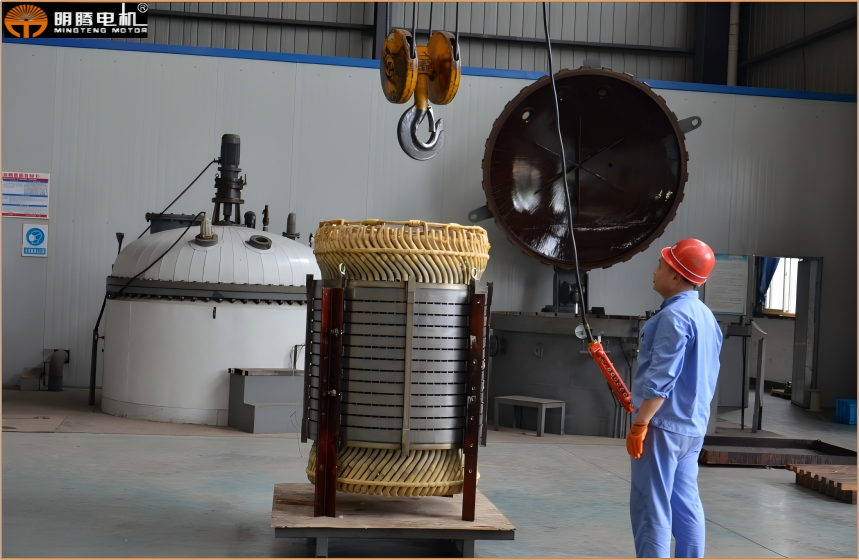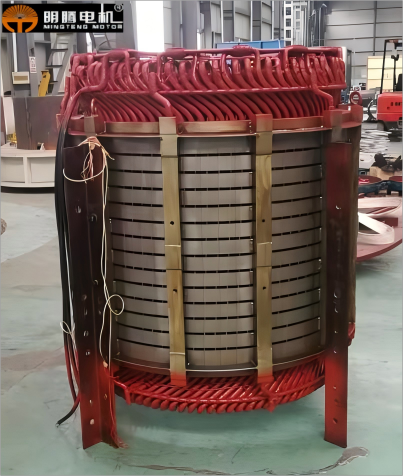1.The role of dipping paint
1. Improve the moisture-proof function of motor windings.
In the winding, there are a lot of pores in the slot insulation, interlayer insulation, phase insulation, binding wires, etc.It is easy to absorb moisture in the air and reduce its own insulation performance. After dipping and drying, the motor is filled with insulating paint and forms a smooth paint film, which makes it difficult for moisture and corrosive gases to invade, thereby enhancing the moisture-proof and corrosion-resistant properties of the winding.
2.Enhance the electrical insulation strength of the winding.
After the windings have been dipped in paint and dried, their turns, coils, phases and various insulating materials are filled with insulating paint with good dielectric properties, making the insulation strength of the windings much higher than before the dipping in paint.
3.Improved heat dissipation conditions and enhanced thermal conductivity.
The temperature rise of the motor during long-term operation directly affects its service life. The heat of the winding is transferred to the heat sink through the slot insulation. The large gaps between the wire insulation paper before varnishing are not conducive to the conduction of heat in the winding. After varnishing and drying, these gaps are filled with insulating varnish. The thermal conductivity of insulating varnish is much better than that of air, thus greatly improving the heat dissipation conditions of the winding.
2.Types of insulating varnish
There are many kinds of insulating paint,Such as epoxy polyester, polyurethane, and polyimide.Generally, the corresponding insulating paint is selected according to the heat resistance level, such as 162 epoxy ester red enamel grade B (130 degrees),9129 epoxy solvent-free topcoat F (155 degrees),197 high purity polyester modified silicone coating H (180 degrees),Under the condition that the insulating paint meets the heat resistance requirement, it should be selected according to the environment in which the motor is located, such as thermal conductivity, moisture resistance, etc.
3.Five types of varnishing processes
1.Pouring
When repairing a single motor, the winding varnishing can be carried out by the pouring process.When pouring, place the stator vertically on the paint dripping tray with one end of the winding facing upward, and use a paint pot or paint brush to pour paint on the upper end of the winding.When the winding gap is filled with paint and begins to seep out from the gap at the other end, turn the stator over and pour paint on the winding at the other end until it is fully poured.
2.Drip leaching
This method is suitable for the varnishing of small and medium-sized electric motors.
①Formula. 6101 epoxy resin (mass ratio), 50% tung oil maleic anhydride, ready for use.
②Preheating: Heat the winding for about 4 minutes, and control the temperature between 100 and 115°C (measured with a spot thermometer), or place the winding in a drying furnace and heat it for about 0.5 hours.
③Drip. Place the motor stator vertically on the paint tray, and start dripping paint manually when the motor temperature drops to 60-70℃. After 10 minutes, turn the stator over and drip paint on the other end of the winding until it is thoroughly soaked.
④Curing. After dripping, the winding is energized for curing, and the winding temperature is maintained at 100-150°C; the insulation resistance value is measured until it is qualified (20MΩ), or the winding is placed in a drying furnace for heating at the same temperature for about 2 hours (depending on the size of the motor), and it is taken out of the oven when the insulation resistance exceeds 1.5MΩ.
3.Roller paint
This method is suitable for the varnishing of medium-sized motors. When rolling the paint, pour the insulating paint into the paint tank, place the rotor in the paint tank, and the paint surface should immerse the rotor winding for more than 200mm. If the paint tank is too shallow and the area of the rotor winding immersed in the paint is small, the rotor should be rolled several times, or the paint should be applied with a brush while the rotor is rolled. Usually rolling 3 to 5 times can make the insulating paint penetrate the insulation.
4.Immersion
When repairing small and medium-sized motors in batches, the windings can be immersed in paint. When immersing, first put a proper amount of insulating paint into the paint can, then hang the motor stator in, so that the paint liquid submerges the stator by more than 200mm. When the paint liquid penetrates all the gaps between the windings and the insulating paper, the stator is lifted up and the paint is dripped. If 0.3~0.5MPa pressure is added during the immersion, the effect will be better.
5.Vacuum pressure immersion
The windings of high-voltage motors and small and medium-sized motors with high insulation quality requirements can be subjected to vacuum pressure dipping. During dipping, the stator of the motor is placed in a closed paint container and moisture is removed using vacuum technology. After the windings are dipped in paint, a pressure of 200 to 700 kPa is applied to the paint surface to allow the paint liquid to penetrate into all gaps in the windings and deep into the pores of the insulating paper to ensure the quality of the dipping.
Anhui Mingteng Permanent-Magnetic Machinery & Electrical Equipment Co., Ltd. (https://www.mingtengmotor.com/)’s varnishing process
Windings being prepared for varnishing
VPI Dip Paint Finish
Our company’s stator winding adopts mature “VPI vacuum pressure dip paint” to make the insulation paint distribution of each part of the stator winding uniform, high-voltage permanent magnet motor insulation paint adopts H-type environmentally friendly epoxy resin insulating paint 9965, low-voltage permanent magnet motor insulating paint is H-type epoxy resin H9901, ensuring the service life of the motor with winding stator core.
Copyright: This article is a reprint of the original link:
https://mp.weixin.qq.com/s/8ZfZiAOTdRVxIfcw-Clcqw
This article does not represent our company’s views. If you have different opinions or views, please correct us!
Post time: Nov-15-2024


